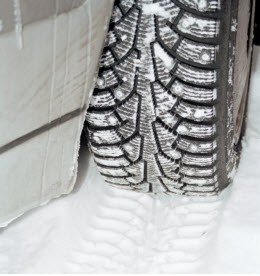Safe Winter Driving

Every year, winter weather is a factor in thousands of preventable motor vehicle collisions. Defensive driving and adjusting driving to the road conditions are key. It’s also important to recognize hazards on the road and leave plenty of time to react and respond so you remain in control of your vehicle.
Tips
Prepare your vehicle in advance and make sure to keep it stocked with emergency supplies.
- Take care of seasonal maintenance in the fall.
- Invest in a full set of winter tires and keep them on your car for the duration of the season. Winter tires are not just for snow, they are designed to perform better and give you improved traction in cold temperatures.
- Check tire air pressure frequently, as it decreases in cold weather.
- Keep essential supplies in your vehicle – a first aid kit, flashlight, blanket, small shovel, sand/kitty litter (for traction), booster cables, extra windshield fluid, a snow brush/ice scraper, an extra set of mittens or gloves, warm hat and boots.
- Keep your gas tank at least half-full at all times throughout winter.
- Carry a fully-charged cell phone and use it only when safe. Do not use while driving unless your device is hands-free.
Make sure you check the weather before you head out. If you decide to drive, make sure you can see properly and be seen, and always let snowplows through.
- Listen to the weather report before you head out and beware of conditions such as blizzards and black ice, which are especially treacherous to drive in.
- Avoid driving in bad weather whenever possible, particularly when visibility and road conditions are compromised.
- Make sure you can see properly and be seen by others by clearing your car of all snow and ice, and turning your lights on when visibility is poor.
- Clear all windows, lights, mirrors, and the roof before you set out.
- Never pass a snowplow—stay well back for your own safety and to allow them to do their job.
- It is extremely dangerous to pass either between or around snowplows, and the road surface is always better behind the plow than in front of it.
- If you get stuck or stranded, don’t panic. Stay with your vehicle for safety and warmth, and call for help.
Slow down and make sure to control skids properly.
- It takes longer to stop on snow-covered or icy roads—reduce your speed and leave ample distance between your vehicle and the one in front of you.
- Allow extra travel time to your destination and extra time and space to change lanes and turn safely.
- Slow down enough to avoid any abrupt turns or stops, which can result in a skid.
- In a skid, drivers need to act contrary to their instincts, steer into the skid and accelerate to regain control of their vehicle.
Take a Red Cross first aid class to learn what to do if you find yourself in an emergency on the road.
Download the free Red Cross First Aid app for access to essential information on the go.
